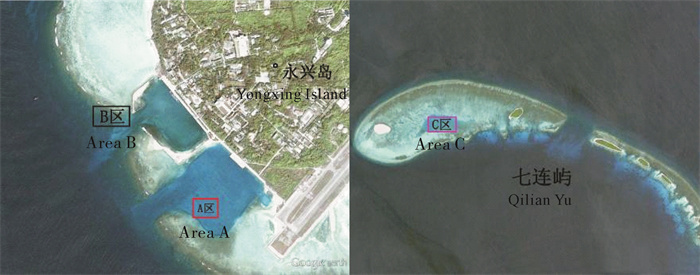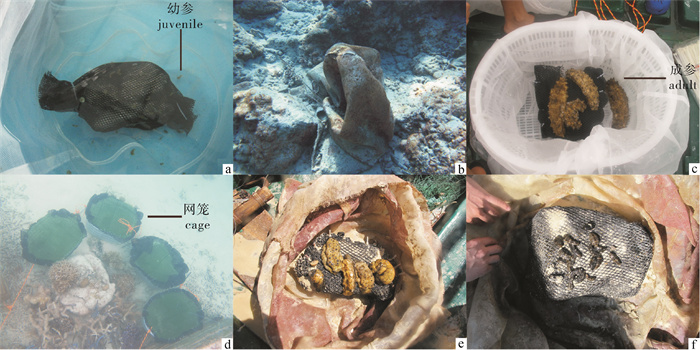Preliminary feasibility study of cage culture of tropical sea cucumber (Stichopus horrens) in the wide
-
摘要:
糙刺参(Stichopus horrens)是一种具有较高经济价值的热带海参, 广泛分布于中国南海海域。近年来, 由于不合理开发, 野生糙刺参资源量不断下滑, 对其进行人工繁育与养殖迫在眉睫。目前, 糙刺参的人工育苗技术已经取得了突破, 而其人工养殖技术尚待完善。为研究热带海参人工养殖及放流的可行性, 2010年~2011年通过在西沙群岛3个不同海区进行了糙刺参的幼参和成参的网笼养殖试验, 定期监测笼内幼参及成参的成活率、生长情况, 研究热带海参野外人工养殖及放流的可行性。结果表明, 热带经济海参糙刺参幼参和成参均可以实现野外网箱养殖。成参在低密度下7个月网笼中成活率100%, 体质量少量下降, 其中在A区网箱养殖成参的效果明显优于C区; 低密度下大规格幼参a(3 cm左右)比小规格幼参a(1.5 cm左右)生长率更快和成活率更高; 而A和B海区由于营养盐、底质有机质含量相对较高, 幼参和成参的养殖效果要优于C区。因此, 利用网笼在野外养殖糙刺参是可行的, 但是必须对海参规格和养殖地点进行合理选择。
Abstract:Stichopus horrens is a tropical sea cucumber with high economic value, widely distributed in South China Sea.Due to unreasonable commercial exploitation, the wild population of S.horrens has reduced sharply so its artificial propagation and aquaculture are urgent.New breakthrough had been made in artificial propagation of S.horrens; however, there is insufficient research on S.horrens aquaculture.We investigate the possibility of culturing and releasing tropical sea cucumber by releasing juveniles and adults in cages in 3 areas at Xisha Islands from 2010 to 2011, and regularly monitoring the survival and growth rate.The results reveal that both juveniles and adults of S.horrens can be cultured in cage in the wild.For the released adults cultured in cages with low density, all survived after 7 months, although their weight decreased slightly.Survival and growth rate of the adults in region A were higher than those in region C.The aquaculture of adults in area A was superior to that in area C.The bigger sized (about 3 cm) juveniles had higher survival and growth rate than the smaller ones (about 1.5 cm).In area A and B, the contents of nutrient salts in seawater and organic compounds in the sediment were higher than those in area C.Therefore, cage culture of S.horrens in the wild is feasible with suitable area and size.
-
Keywords:
- tropical sea cucumber /
- Stichopus horrens /
- aquaculture /
- restocking
-
海参被誉为海产“八珍”之一, 具有增强机体免疫、提高记忆力、延缓性腺衰老、抗凝血、抗疲劳、抗肿瘤及防止动脉粥硬化和糖尿病等作用[1-3]。海参以海底碎屑、腐殖质为食,具有海洋清道夫的美称,在海洋生态系统中具有重要的作用[4]。随着人们的保健意识和生活水平的提高,海参需求量不断增加,野生海参资源已无法满足市场的需求而受到破坏严重,因此,不少国家已转向人工繁育和养殖以获得海参产品[5-7]。海参的人工繁育及养殖不仅解决人们日益增长的需求,同时为保护和恢复其野生资源提供了保障。海参野外放流增殖被认为是恢复海参野生种质资源,提高野生种群数量的有效方法,目前,仿刺参(Apostichopus japonicus)以及糙海参(Holothuria scabra)的人工放流增殖已取得了成功[8-12]。
中国分布有二十余种可食用的海参,除仿刺参外,其余均是热带海参。糙刺参(Stichopus horrens)是中国可食用的热带海参之一,具有较高的食用和药用价值[13-14]。糙刺参广泛分布于热带太平洋-印度洋区域,在中国主要分布于海南、台湾、西沙群岛[13-15]。糙刺参白天躲藏于珊瑚礁或石缝中,夜晚出来活动[16]。近年来,由于人们的酷渔滥捕,中国的野生糙刺参资源量不断下滑,因此,对其进行人工繁育与养殖迫在眉睫。
热带海参是一个研究热点,多种热带海参已在多个国家人工繁育成功[17-22]。特别是热带海参糙海参已经实现规模化育苗,并带来了明显的环境与经济效益[5, 17, 23-25]。目前,热带海参糙刺参在西沙群岛人工繁育获得了成功[26],这为其人工养殖和放流增殖提供了稳定的种苗,但是对其进行人工养殖和放流增殖尚处于起步阶段。笔者利用网笼在西沙海域进行了糙刺参的养殖试验,探讨了放养规格及地点对海参生长与成活率的影响,以为热带海参的资源恢复与可持续利用提供科学依据。
1. 材料与方法
1.1 材料
糙刺参成参为渔民在西沙海域潜水捕获,试验前暂养于西沙永兴岛实验基地。糙刺参幼参来自于2010年与2011年西沙永兴岛实验基地人工繁育的苗种。按大小分成2个等级:a)1.5 cm左右;b)3.0 cm左右。放流网笼内放置PVC管、珊瑚石、波纹板作为海参的附着基,用网袋包裹以后放于网笼中。
分别于2012年2月、5月、10月高潮时在A、B和C 3个放流海域取表、底层水样,分析水质;取底质泥沙样品分析底质有机物含量。
1.2 试验地点
试验选取3个区域(图 1):A区(N16°49′36.09″,E112°19′54.85″)永兴岛港池内;B区(N116°49′55.79″,E112°19′42.61″)永兴岛港池外;C区(N116°58′43.33″,E112°14′41.70″)七连屿赵述岛泻湖内。
1.3 方法
1.3.1 B区
2011年1月,2种规格的幼参(a、b),按照每笼60头、80头、100头和120头的密度放于网笼中,每个密度设5个平行。每个网笼内用塑料吊牌编号,封闭袋口后置于海水中运输到B区域,在此面积为1 km2的区域内每隔100 m随机放下1个网笼。网笼规格为直径60 cm、高60 cm,外层为5目的尼龙袋子,里层为12目的筛绢网袋(图 2-a)。分别于50 d、110 d和180 d后潜水回捕网笼。测量笼内海参的体质量、体长和数量。测量完毕后放回笼内,重新封口后放于原处(图 2-b)。
1.3.2 A区
2011年7月A海区中成参网笼为直径60 cm、高40 cm的钢筋骨架,外层为5目的尼龙网笼。通过3根钢筋固定于海底。成参的密度为每笼3头、6头和8头,每个密度设3个平行。2011年9月A海区放置的幼参网笼为直径50 cm、高40 cm的塑料框,框内为100目和40目的筛绢网,塑料栅栏封口,通过3根钢筋固定于海底。每笼放养40头幼参,设置3个平行。分别于15 d、30 d和60 d后潜水回捕网笼,测量海参的体长,体质量和数量。测量完毕后重新封闭网笼,固定于海底原处。
1.3.3 C区
2011年10月C区放置的成参及幼参的网笼装置相同,规格为直径50 cm、高40 cm的塑料框,框内放置100目和40目的筛绢网,塑料栅栏封口。通过3根钢筋固定于海底。笼内成参密度为每笼3头,设置3个平行(图 2-c~d)。幼参a和b的密度分别为每笼40头和20头,设置3个平行。分别于5个月、8个月和12个月后潜水回捕网笼,测量海参体长、体质量和数量。测量完毕后将海参重新放回笼内固定于原位置(图 2-e~f)。
1.3.4 海参测量方法及水质检测方法
随机测量网笼内10头海参(海参数量不足10头时选取所有海参)的体质量和体长,取平均值作为结果。测量方法和水质、底质监测方法为:
体质量测量是将海参倒立竖直放置,使海参体腔内的水从肛门排尽后,将海参轻轻放置于干纱布上,吸干体表的水后称量。
体长测量是将海参置于水盆中,等其自然伸展后测量其长度。
水质及底质监测是用YSI6920多功能水质分析仪现场测定采样位置的温度、盐度、酸碱度、溶解氧和叶绿素;水质样品采集后立即运回实验室按照《海洋调查规范》(GB/T 12763-2007) [25]和《海洋监测标准》(GB 17378-2007) [26]规定的方法进行分析。分析项目及方法为:1)亚硝酸盐分析用重氮-偶氮法;2)硝酸盐分析用锌镉还原法;3)氨氮分析用次溴酸钠氧化法;4)活性磷酸盐分析用抗坏血酸还原磷钼蓝法;5)活性硅酸盐分析用硅钼黄法;6)底质有机物分析为沉积物60 ℃烘干后,利用灰化法测定其有机质(OM,%)质量分数。各项水质数据除水深和底质有机物外,均按照表层水和底层水的平均值作为该点的观测值。
1.3.5 统计方法
采用SPSS 13.0软件对各试验数据进行统计分析,其中百分比数据均经平方根反正弦转换后进行统计分析,而在结果中仍显示为原始数据,P < 0.05表示数据间有显著差异。
2. 结果
2.1 海域水质和底质情况
3次测量3个区域(A区、B区和C区)的水质和底质数据的平均值见表 1。同期内3个海区的温度、酸碱度、盐度、溶解氧几乎没有差异(P>0.05)。从C区到B区、A区水体中叶绿素、亚硝酸盐、硝酸盐、铵盐、磷酸盐、硅酸盐及底质中的有机质含量依次升高,且A区与C区具有显著差异(P<0.05)。
表 1 A、B、C海区水质和底质监测数据(X±SD,n=3)Table 1 Water quality and sediments in area A, B and C项目
item区域area A B C 底质sediment 珊瑚沙+海泥 珊瑚沙+海泥 珊瑚沙 水深/m depth 8.9 8.2 3.5 水温/℃ temperature 29.61±0.97 29.72±0.74 29.66±0.92 盐度salinity 32.48±0.10 32.55±0.88 32.65±0.71 酸碱度pH 8.59±0.01 8.59±0.01 8.59±0.006 ρ(溶解氧)/mg·L-1 DO 6.46±0.03 6.48±0.07 6.59±0.05 ρ(叶绿素)/μg·L-1 chlorophyll 0.87±0.40 0.64±0.13 0.50±0.10 ρ(有机质)/mg·L-1 organic matter 4.64±0.34 4.38±0.14 4.13±0.16 ρ(亚硝酸盐)/mg·L-1 nitrite 0.20±0.18 0.12±0.10 0.095±0.08 ρ(硝酸盐)/mg·L-1nitrate 2.94±2.61 1.52±1.63 0.96±0.87 ρ(铵盐)/mg·L-1ammonium 0.092±0.018 0.066±0.030 0.058±0.024 ρ(磷酸盐)/ mg·L-1phosphate 0.093±0.074 0.085±0.070 0.07±0.054 c(硅酸盐)/μmol·L-1silicate 1.45±0.096 1.16±0.058 0.96±0.087 2.2 B区
50 d后在B区回捕网笼6个,测量海参各项数据见表 2。幼参a平均生长速率为0.03 cm · d-1、0.02 g · d-1,成活率为23.7%;幼参b平均生长速率为0.03 cm · d-1、0.032 g · d-1,成活率为31.65%。2种规格幼参的成活率和体质量增长率具有显著性差异(P<0.05)。由于网笼未固定,其位置随着海流移动发生变化,有些网笼出现不同程度的破损。110 d和180 d后放流区域内已经无法找到网笼,只发现部分散落的附着基和破损的网笼碎片。
表 2 2011年1月B区幼参数据(X±SD,n=3)Table 2 Data of juveniles in area B in Jan., 2011幼参
juvenile试验开始initial 50 d后50 d later 体长/cm
length体质量/g
weight回捕网笼/个
recapture number成活率/%
survival体长/cm
length体质量/g
weighta 1.57±0.32 0.23±0.15 3 23.7±5.6 3.07±0.53 1.24±0.62 b 3.19±0.52 1.18±0.64 3 31.65±13.1 4.7±0.72 2.8±1.39 2.3 A区
A区成参的养殖数据见表 3。60 d后3种密度下养殖的成参体质量均出现下降。每头成参60 d内的体质量平均变化量依次为-21.1 g、-42.2 g和-121.2 g,相同时期内不同密度养殖的海参体质量变化量具有显著差异(P<0.05)。60 d内3种密度下的海参成活率超过91.6%,随着密度的下降而上升。
表 3 2011年7月A区成参数据(X±SD,n=3)Table 3 Data of adults in area A in Jul., 2011试验开始initial 15 d后15 d later 30 d后30 d later 60 d后60 d later 密度/头·笼-1
density总体质量/g
total weight成活率/%
survival总体质量/g
total weight成活率/%
survival总体质量/g
total weight成活率/%
survival总体质量/g
total weight3 834.1±215.3 100±0 837.2±210.5 100±0 813.8±157.4 100±0 770.8±80.4 5 1 338.8±60.0 100±0 1 249.2±11.7 100±0 1 227±4 65.8 93.3±11.5 1 149.3±54.8 8 2 138.3±654.2 100±0 2 031.4±667.4 95.8±7.2 1 518.2±184.1 91.6±11.5 1 280.1±158.8 A区幼参的养殖数据见表 4。60 d内a规格幼参平均生长率为0.033 cm · d-1、0.020 g · d-1,成活率为79.3%。
表 4 2011年9月A区幼参数据(X±SD,n=3)Table 4 Data of juveniles in area A in Sep., 2011养殖时间/d culture time 成活率/% survival 体长/cm length 体质量/g weight 0 - 1.19±0.20 0.13±0.06 15 95.2±5.0 1.72±0.29 0.60±0.20 30 90.1±3.7 2.38±0.60 0.95±0.26 60 79.3±3.0 3.17±0.46 1.38±0.40 2.4 C区放流
C区成参养殖数据见表 5。7个月内无死亡,但体质量出现负增长。每头成参体质量平均减少量为180.8 g。由于台风原因,1年后网笼被珊瑚砂完全掩埋,全部海参死亡。
表 5 2011年10月C区成参数据(X±SD,n=3)Table 5 Data of adults in region C in Oct., 2011养殖时间/d culture time 成活率/% survival 总体质量/g total weight 0 / 1089.4±134.2 120 100±0 734.7±97.3 280 100±0 547±56.5 幼参在C区的养殖数据见表 6。7个月内规格a幼参平均生长率为0.009 cm · d-1、0.004 8 g ·d-1,成活率为2.12%。规格b幼参平均生长率为0.010 cm · d-1、0.006 6 g · d-1,成活率为6.5%。2种规格幼参的成活率和体质量生长率具有显著性差异(P<0.05)。
表 6 2011年10月C区幼参数据(X±SD,n=3)Table 6 Data on the juveniles in area C in Oct., 2011幼参
juv-enile试验开始initial 4个月4 months later 7个月7 months later 体长/cm
length体质量/g
weight成活率/%
survival体长/cm
length体质量/g
weight成活率/%
survival体长/cm
length体质量/g
weighta 1.26±0.30 0.19±0.12 43.2±4.5 1.76±0.73 0.32±0.19 2.12±0.95 3.15±1.45 1.21±1.03 b 3.43±0.62 1.54±0.7 90.0±7.1 4.51±1.04 2.17±0.79 6.50±0.71 5.50±1.73 2.92±1.31 3. 讨论
A和B海区由于靠近人类生活区域,有较多外源性营养盐和有机物质输入,其水体中营养盐、底质有机物、叶绿素含量高于C区。自然环境下海参主要生活在暗礁和沙底,经济海参大多营沉积物摄食生活,能够选择摄食海泥、细菌、原生动物、硅藻和动植物碎屑等有机物含量高的颗粒和沉积物[27-31]。在营养盐丰富、底质有机物丰富、浮游藻类多的海域,海参所需的饵料将会更加丰富。观察回捕的网笼可以看出,在A和B海区回捕的网笼,笼内和网上覆盖的藻类及其他附着物明显高于C区。
对于成参试验,在A和C海区笼内成参均具有较高的成活率,在营养物质匮乏的C区能保持7个月内无死亡,这说明糙刺参对饵料匮乏的逆境具有相当强的抵抗力。在A和C海区养殖的成参均出现不同程度的负增长,说明成参对饵料的需求量比幼参大,在笔者试验网笼限定的空间下,成参不能从自然海域中获得的充足的饵料来维持自身的生长。体质量减少量表现为在高密度下(8头· 笼-1)笼养的成参显著大于低密度下(3头· 笼-1)的成参(P<0.05)。低密度下(3头· 笼-1)的成参在A区的体质量减少量[10.6 g ·(月· 头)-1]显著低于C区[25.8 g ·(月· 头)-1 (P < 0.05)]。试验结果说明养殖密度和养殖区域内的天然饵料丰富程度对成参养殖效果的影响显著。如果在其他条件不变的情况下,为笼内成参提供外源性饵料,满足成参生长的营养需求,成参的网笼养殖将具备可行性,它将成为培育种参的有效手段,为海参的繁育提供重要种质资源。
对于幼参试验,3个海区网笼养殖的幼参,体质量均出现正增长,但是总体生长缓慢。说明在笼内限制幼参活动空间的条件下,自然海域内提供的饵料仍显不足。相比之下,在A和B区笼内幼参生长速度显著高于C区的幼参(P < 0.05),结合A、B区和C区的营养盐数据和底质有机物数据对比,说明A和B海区中能够提供比C海区更多的饵料供幼参生长发育。在相同情况下,b规格幼参比a规格幼参体质量增长更多,成活率更高。说明在此试验条件下大规格幼参b的网笼养殖效果更好。此结果在刺参的放流研究中得到印证,如1986年9月~10月于蓬莱海域笼式放流海参,观察发现放流海参规格越大成活率越高,最佳放流海参规格为25 mm[32]。据报道,1985年11月上旬在辽宁长海县海洋岛大套海底,放流幼参35.3万头,1.5年后幼参成活率为55.3%[11]。与之相比自然条件下网笼养殖的糙刺参幼参的成活率较低,其原因可能有以下几点:1)饵料不足是糙刺参幼参成活率低、生长缓慢的直接原因。调查发现A和B区的底质有机物含量高于C区,但3个海区的底质有机物含量均比较低,在限定海参活动范围的情况下,不能得到充足的饵料。2)在B区的幼参网笼没有固定,随着海流而移动,容易损伤幼参;幼参能从磨损的网笼破洞中逃逸,网笼中幼参的实际成活数应高于检测的数量。3)在C区幼参网笼虽然已经固定,但是其底质为珊瑚砂,随着海流部分珊瑚砂进入网笼越积越多,使得幼参生活空间继续缩小,1年后检查珊瑚砂甚至完全掩埋网笼,使得幼参的成活率明显低于刺参幼参的放流成活率。
因此在西沙海域,饵料是限制幼参和成参野外笼养成活率和生长率的重要因素。在网笼的空间内糙刺参获得的自然饵料太少,导致成参体质量出现负增长,幼参死亡率相对较高。但从该研究中可以推断出,糙刺参适合于野外网笼养殖,同等环境条件下如果有外源性人工饵料的添加,将会提高海参的生长率和成活率。如果在西沙海域放流增殖糙刺参,在开放的条件下放流海参能够获得更大的活动范围,从而获得更多的自然海域的饵料,幼参和成参的成活率和生长率应该大于笼内放流。此研究得出以下认识:糙刺参的网笼养殖以及放流增殖具有可行性,应该选取底质中有机物含量较高、天然饵料较多的海域,估算合适的密度,选择较大规格的幼参,以提高成活率和生长率,获得更大的效益。
-
表 1 A、B、C海区水质和底质监测数据(X±SD,n=3)
Table 1 Water quality and sediments in area A, B and C
项目
item区域area A B C 底质sediment 珊瑚沙+海泥 珊瑚沙+海泥 珊瑚沙 水深/m depth 8.9 8.2 3.5 水温/℃ temperature 29.61±0.97 29.72±0.74 29.66±0.92 盐度salinity 32.48±0.10 32.55±0.88 32.65±0.71 酸碱度pH 8.59±0.01 8.59±0.01 8.59±0.006 ρ(溶解氧)/mg·L-1 DO 6.46±0.03 6.48±0.07 6.59±0.05 ρ(叶绿素)/μg·L-1 chlorophyll 0.87±0.40 0.64±0.13 0.50±0.10 ρ(有机质)/mg·L-1 organic matter 4.64±0.34 4.38±0.14 4.13±0.16 ρ(亚硝酸盐)/mg·L-1 nitrite 0.20±0.18 0.12±0.10 0.095±0.08 ρ(硝酸盐)/mg·L-1nitrate 2.94±2.61 1.52±1.63 0.96±0.87 ρ(铵盐)/mg·L-1ammonium 0.092±0.018 0.066±0.030 0.058±0.024 ρ(磷酸盐)/ mg·L-1phosphate 0.093±0.074 0.085±0.070 0.07±0.054 c(硅酸盐)/μmol·L-1silicate 1.45±0.096 1.16±0.058 0.96±0.087 表 2 2011年1月B区幼参数据(X±SD,n=3)
Table 2 Data of juveniles in area B in Jan., 2011
幼参
juvenile试验开始initial 50 d后50 d later 体长/cm
length体质量/g
weight回捕网笼/个
recapture number成活率/%
survival体长/cm
length体质量/g
weighta 1.57±0.32 0.23±0.15 3 23.7±5.6 3.07±0.53 1.24±0.62 b 3.19±0.52 1.18±0.64 3 31.65±13.1 4.7±0.72 2.8±1.39 表 3 2011年7月A区成参数据(X±SD,n=3)
Table 3 Data of adults in area A in Jul., 2011
试验开始initial 15 d后15 d later 30 d后30 d later 60 d后60 d later 密度/头·笼-1
density总体质量/g
total weight成活率/%
survival总体质量/g
total weight成活率/%
survival总体质量/g
total weight成活率/%
survival总体质量/g
total weight3 834.1±215.3 100±0 837.2±210.5 100±0 813.8±157.4 100±0 770.8±80.4 5 1 338.8±60.0 100±0 1 249.2±11.7 100±0 1 227±4 65.8 93.3±11.5 1 149.3±54.8 8 2 138.3±654.2 100±0 2 031.4±667.4 95.8±7.2 1 518.2±184.1 91.6±11.5 1 280.1±158.8 表 4 2011年9月A区幼参数据(X±SD,n=3)
Table 4 Data of juveniles in area A in Sep., 2011
养殖时间/d culture time 成活率/% survival 体长/cm length 体质量/g weight 0 - 1.19±0.20 0.13±0.06 15 95.2±5.0 1.72±0.29 0.60±0.20 30 90.1±3.7 2.38±0.60 0.95±0.26 60 79.3±3.0 3.17±0.46 1.38±0.40 表 5 2011年10月C区成参数据(X±SD,n=3)
Table 5 Data of adults in region C in Oct., 2011
养殖时间/d culture time 成活率/% survival 总体质量/g total weight 0 / 1089.4±134.2 120 100±0 734.7±97.3 280 100±0 547±56.5 表 6 2011年10月C区幼参数据(X±SD,n=3)
Table 6 Data on the juveniles in area C in Oct., 2011
幼参
juv-enile试验开始initial 4个月4 months later 7个月7 months later 体长/cm
length体质量/g
weight成活率/%
survival体长/cm
length体质量/g
weight成活率/%
survival体长/cm
length体质量/g
weighta 1.26±0.30 0.19±0.12 43.2±4.5 1.76±0.73 0.32±0.19 2.12±0.95 3.15±1.45 1.21±1.03 b 3.43±0.62 1.54±0.7 90.0±7.1 4.51±1.04 2.17±0.79 6.50±0.71 5.50±1.73 2.92±1.31 -
[1] CHEN J. Overview of sea cucumber farming and sea ranching practices in China[J]. SPC Beche-de-Mer Inf Bull, 2003, 18: 18-23. https://xueshu.baidu.com/usercenter/paper/show?paperid=edf475df61969b3eb91e4334debfbd5c&site=xueshu_se&hitarticle=1
[2] WEN J, HU C Q, FAN S G. Chemical composition and nutritional quality of sea cucumbers[J]. J Sci Food Agric, 2010, 90(14): 2469-2474. doi: 10.1002/jsfa.4108
[3] BORDBAR S, ANWAR F, SAARI N. High-value components and bioactives from sea cucumbers for functional foods: a review[J]. Mar Drugs, 2011, 9(10): 1761-1805. doi: 10.3390/md9101761
[4] YINGST J Y. Factors influencing rates of sediment ingestion by Parastichopus parvimensis (Clark), an epibenthic deposit-feeding holothurian[J]. Est Coast Shelf Sci, 1982, 14(2): 119-134. doi: 10.1016/S0302-3524(82)80040-6
[5] BATTAGLENE S C, SEYMOUR J E, RAMOFAFIA C. Survival and growth of cultured juvenile sea cucumbers, Holothuria scabra[J]. Aquaculture, 1999, 178(3): 293-322. https://xueshu.baidu.com/usercenter/paper/show?paperid=27cb71ec68453bc8096e7e2b59c42dd4&site=xueshu_se
[6] BRUCKNER A W, JOHNSON K A, FIELD J D. Conservation strategies for sea cucumbers: can a CITES Appendix Ⅱ listing promote sustainable international trade?[J]. SPC Beche-de-mer Inf Bull, 2003, 18: 24-33. https://xueshu.baidu.com/usercenter/paper/show?paperid=947d26566cb10033c54ee485979855e7&site=xueshu_se&hitarticle=1
[7] HU C Q, XU Y H, WEN J, et al. 2010. Larval development and juvenile growth of the sea cucumber Stichopus sp. (Curry fish)[J]. Aquaculture, 2010, 300(1): 73-79. https://xueshu.baidu.com/usercenter/paper/show?paperid=db554a253a7b31594f39f4428dcef11e&site=xueshu_se&hitarticle=1
[8] DANCE S K, LANE I, BELL J D. Variation in short-term survival of cultured sandfish Holothuria scabra released in mangrove-seagrass and coral reef flat habitats in Solomon Islands[J]. Aquaculture, 2003, 220(1): 495-505. https://xueshu.baidu.com/usercenter/paper/show?paperid=c858f6a06a43b5ef6e21cfee7039059e&site=xueshu_se
[9] 张凤瀛, 吴宝玲, 李万滋, 等. 刺参的人工养殖和增殖的初步报告[J]. 动物学杂志, 1958(2): 65-73. https://xueshu.baidu.com/usercenter/paper/show?paperid=79dbcb01d7a5aa5b448534c8be66b3ba&site=xueshu_se&hitarticle=1 [10] 张煜, 马志珍, 刘永宏, 等. 港东沿海刺参增殖试验[J]. 海洋水产研究, 1982(4): 43-53. https://xueshu.baidu.com/usercenter/paper/show?paperid=021d0c7f67b0538e8ba31881939523af&site=xueshu_se [11] 牟绍敦, 李庆彪, 张晓燕. 刺参人工种苗的放流增殖[J]. 海洋湖沼通报, 1986(3): 44-49. [12] 隋锡林, 林祥辉, 刘兴盛, 等. 刺参人工种苗放流试验研究[J]. 海洋与湖沼, 1991, 22(2): 175-180. https://www.cnki.com.cn/Article/CJFDTotal-HYFZ199102012.htm [13] 廖玉麟. 我国的海参[J]. 生物学通报, 2001, 35: 1-4. https://xueshu.baidu.com/usercenter/paper/show?paperid=4ecc28cd52a048e4b91e3e34d4dcf894&site=xueshu_se [14] RASOLOFONIRINA R, MARA E, JANGOUX M. Sea cucumber fishery and mariculture in Madagascar: a case study of Toliara, south-west of Madagascar[G]. FAO Fisheries Technical Paper, 2005: 133-150. [15] MASSI C, ZULFIGAR Y, HWAI T S, et al. The genus Stichopus (Echinodermata: Holothuroidea) from Johore Marine Park (Malaysia) with the description of two new species[J]. Kon Belg Inst Natuurwet, Biologie, 2002, 72: 73-99. https://xueshu.baidu.com/usercenter/paper/show?paperid=1t6d04x02u0q069014390e50rk352003&site=xueshu_se
[16] HEARN A, PINILLOS F. Baseline information on the warty sea cucumber Stichopus horrens in Santa Cruz, Galapagos, prior to the commencement of an illegal fishery[J]. SPC Beche-de-Mer Inf Bull, 2006, 24: 3-10.
[17] RAMOFAFIA C, GERVIS M, BELL J. Spawning and early larval rearing of Holothuria atra[J]. SPC Beche-de-Mer Inf Bull, 1995, 7: 2-6. https://xueshu.baidu.com/usercenter/paper/show?paperid=991ac5e2e6629ca2d83f90e04c68598e&site=xueshu_se&hitarticle=1
[18] ARCHER J E. Aspects of the reproductive and larval biology and ecology, of the temperate holothurian Stichopus mollis (Hutton)[M]. New Zealand: University of Auckland, 1996.
[19] HAMEL J F, HIDALGO R Y, MERCIER A. Larval development and juvenile growth of the Galapagos sea cucumber Isostichopus fuscus[J]. SPC Beche-de-mer Inf Bull, 2003, 18: 3-8.
[20] RAMOFAFIA C, BYRNE M, BATTAGLENE S C. Development of three commercial sea cucumbers, Holothuria scabra, H. fuscogilva and Actinopyga mauritiana: larval structure and growth[J]. Mar Freshw Res, 2003, 54(5): 657-667. doi: 10.1071/MF02145
[21] LAXMINARAYANA A. Induced spawning and larval rearing of the sea cucumbers, Bohadschia marmorata and Holothuria atra in Mauritius[J]. SPC Beche-de-mer Inf Bull, 2005, 22: 48-52. https://xueshu.baidu.com/usercenter/paper/show?paperid=5c5700c38eef08117184f8865c906a7c&site=xueshu_se
[22] DABBAGH A, SEDAGHAT M R, RAMESHI H, et al. Breeding and larval rearing of the sea cucumber Holothuria leucospilota Brandt (Holothuria vegabunda Selenka) from the northern Persian Gulf, Iran[J]. SPC Beche-de-mer Inf Bull, 2011, 31: 35-38. https://xueshu.baidu.com/usercenter/paper/show?paperid=1t5k0xg06w0706s0ws5k0pf0cg144088&site=xueshu_se&hitarticle=1
[23] GIRASPY D A B, IVY W G. Australia's first commercial sea cucumber culture and sea ranching project in Hervey Bay, Queensland, Australia[J]. SPC Beche-de-mer Inf Bull, 2005, 21: 29-31. https://xueshu.baidu.com/usercenter/paper/show?paperid=63e5252821d234122f6b71f470aa615b&site=xueshu_se&hitarticle=1
[24] GIRASPY D A B., WALSALAM I G. Aquaculture potential of the tropical sea cucumbers Holothuria scabra and H. lessoni in the Indo-Pacific region[J]. SPC Beche-de-mer Inf Bull, 2010, 30: 29-32.
[25] EECKHAUT I, LAVITRA T, RASOFORININA R, et al. Madagascar Holothurie SA: the first trade company based on sea cucumber aquaculture in Madagascar[J]. SPC Beche-de-mer Inf Bull, 2008, 28: 22-23. https://xueshu.baidu.com/usercenter/paper/show?paperid=1q6300w07v6x0g307f3a0j40v8497886&site=xueshu_se&hitarticle=1
[26] HU C Q, LI H P, XIA J J, et al. Spawning, larval development and juvenile growth of the sea cucumber Stichopus horrens[J]. Aquaculture, 2013, 404/405: 47-54. https://xueshu.baidu.com/usercenter/paper/show?paperid=320753ea1606b4608117300abef60106&site=xueshu_se&hitarticle=1
[27] 国家技术监督局. GB/T 12763.4-2007海洋调查规范-第四部分: 海水化学要素调查[S]. 北京: 中国标准出版社, 2007: 13-28. [28] 国家技术监督局. GB 17378.4-2007海洋监测规范-第四部分: 海水分析[S]. 北京: 中国标准出版社, 2008: 101-121. [29] CHOE S. Study of sea cucumber: morphology, ecology and propagation of sea cucumber[M]. Tokyo: Kaibundou Publishing House, 1963: 133-138.
[30] YINGST J Y. The utilization of organic matter in shallow marine sediments by an epibenthic deposit feeding holothurian[J]. J Exp Mar Biol Ecol, 1976, 23(1): 55-69. https://xueshu.baidu.com/usercenter/paper/show?paperid=49273885fbc0b58fb99ca94e61139442&site=xueshu_se&hitarticle=1
[31] MORIARTY D J W. Feeding of Holothuria atra and Sticopus chloronotus on bacteria, organic carbon and organic nitrogen in sediments of the Great Barrier Reef[J]. Mar Freshw Res, 1982, 33(2): 255-263. https://xueshu.baidu.com/usercenter/paper/show?paperid=8a0d0bab0a646d99f2b7101badd7c310&site=xueshu_se&hitarticle=1
[32] HAMMOND L S. Nutrition of deposit-feeding holothuroids and echinoids (Echinodermata) from a shallow reef lagoon, Discovery Bay, Jamaica[J]. Mar Ecol Prog Ser, Oldendorf, 1983, 10(3): 297-305. https://xueshu.baidu.com/usercenter/paper/show?paperid=6d38d6847b6c1955162e16b9512b6f23&site=xueshu_se&hitarticle=1
[33] DAR M A, AHMAD H O. The feeding selectivity and ecological role of shallow water holothurians in the Red Sea[J]. Beche-de-mer Inf Bull, 2006, 24: 11-21. https://xueshu.baidu.com/usercenter/paper/show?paperid=7fa224b999fba0a821d9ce0943ffed40&site=xueshu_se
[34] 刘永宏, 李馥馨, 宋本祥. 刺参Apostichopus japonicus人工种苗放流技术研究——Ⅱ放流人工种苗规格[J]. 中国海洋药物, 1991, 10(1): 38-42. -
期刊类型引用(6)
1. 鲍承飞,高婷,林叔森,胡聪,宋伟华,臧迎亮. TR鲍参人工鱼礁的鲍参增养殖试验. 安徽农业科学. 2017(31): 122-125+127 .  百度学术
百度学术
2. 钟鸣,张吕平,胡超群. 不同的水煮条件对花刺参体壁形态结构和蛋白溶失的影响. 南方水产科学. 2016(01): 23-29 .  本站查看
本站查看
3. 陆振,杨求华,林琪,黄瑞芳,何丽斌,葛辉,周宸,杜虹. 福建吊笼养殖仿刺参肠道菌群结构分析. 南方水产科学. 2016(03): 9-14 .  本站查看
本站查看
4. 于渤湛. 基于海参生存环境下刺参的养殖技术研究. 北京农业. 2014(30): 192 .  百度学术
百度学术
5. 杨求华,葛辉,方旅平,林琪,何丽斌,周宸. 池塘养殖刺参病原菌塔式弧菌的分离与鉴定. 南方水产科学. 2014(04): 45-51 .  本站查看
本站查看
6. 姜松,王军红,范嗣刚,温为庚,黄桂菊,刘宝锁,张博,喻达辉. 添加光合细菌对糙海参幼苗培育阶段的影响研究. 南方水产科学. 2014(06): 78-82 .  本站查看
本站查看
其他类型引用(4)




 下载:
下载:

 粤公网安备 44010502001741号
粤公网安备 44010502001741号
